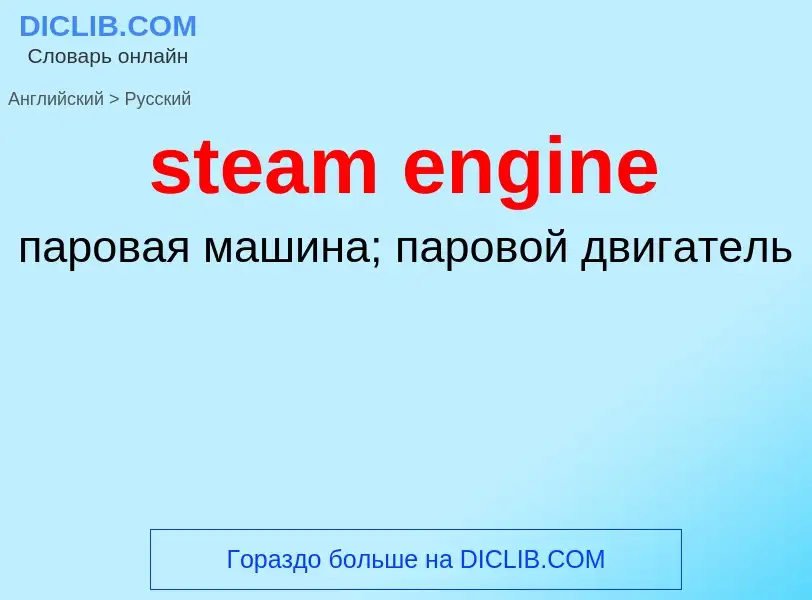Vertaling en analyse van woorden door kunstmatige intelligentie ChatGPT
Op deze pagina kunt u een gedetailleerde analyse krijgen van een woord of zin, geproduceerd met behulp van de beste kunstmatige intelligentietechnologie tot nu toe:
- hoe het woord wordt gebruikt
- gebruiksfrequentie
- het wordt vaker gebruikt in mondelinge of schriftelijke toespraken
- opties voor woordvertaling
- Gebruiksvoorbeelden (meerdere zinnen met vertaling)
- etymologie
steam engine - vertaling naar russisch
общая лексика
паровой двигатель
Wikipedia

A steam engine is a heat engine that performs mechanical work using steam as its working fluid. The steam engine uses the force produced by steam pressure to push a piston back and forth inside a cylinder. This pushing force can be transformed, by a connecting rod and crank, into rotational force for work. The term "steam engine" is generally applied only to reciprocating engines as just described, not to the steam turbine. Steam engines are external combustion engines, where the working fluid is separated from the combustion products. The ideal thermodynamic cycle used to analyze this process is called the Rankine cycle. In general usage, the term steam engine can refer to either complete steam plants (including boilers etc.), such as railway steam locomotives and portable engines, or may refer to the piston or turbine machinery alone, as in the beam engine and stationary steam engine.
Although steam-driven devices were known as early as the aeolipile in the first century AD, with a few other uses recorded in the 16th century, in 1606 Jerónimo de Ayanz y Beaumont patented his invention of the first steam-powered water pump for draining mines. Thomas Savery is considered the inventor of the first commercially used steam powered device, a steam pump that used steam pressure operating directly on the water. The first commercially successful engine that could transmit continuous power to a machine was developed in 1712 by Thomas Newcomen. James Watt made a critical improvement in 1764, by removing spent steam to a separate vessel for condensation, greatly improving the amount of work obtained per unit of fuel consumed. By the 19th century, stationary steam engines powered the factories of the Industrial Revolution. Steam engines replaced sails for ships on paddle steamers, and steam locomotives operated on the railways.
Reciprocating piston type steam engines were the dominant source of power until the early 20th century, when advances in the design of electric motors and internal combustion engines resulted in the gradual replacement of steam engines in commercial usage. Steam turbines replaced reciprocating engines in power generation, due to lower cost, higher operating speed, and higher efficiency.


![class]] of engine was built in 1942–1950 and operated until 1988. class]] of engine was built in 1942–1950 and operated until 1988.](https://commons.wikimedia.org/wiki/Special:FilePath/52 8134 Hoentrop 2012-09-16.jpg?width=200)

![[[Centrifugal governor]] in the [[Boulton & Watt engine]] 1788 [[Lap Engine]]. [[Centrifugal governor]] in the [[Boulton & Watt engine]] 1788 [[Lap Engine]].](https://commons.wikimedia.org/wiki/Special:FilePath/Boulton and Watt centrifugal governor-MJ.jpg?width=200)
![An industrial boiler used for a [[stationary steam engine]] An industrial boiler used for a [[stationary steam engine]]](https://commons.wikimedia.org/wiki/Special:FilePath/Dampfkessel für eine Stationärdampfmaschine im Textilmuseum Bocholt.jpg?width=200)
![A rotor of a modern [[steam turbine]], used in a [[power plant]] A rotor of a modern [[steam turbine]], used in a [[power plant]]](https://commons.wikimedia.org/wiki/Special:FilePath/Dampfturbine Laeufer01.jpg?width=200)
![[[Jacob Leupold]]'s steam engine, 1720 [[Jacob Leupold]]'s steam engine, 1720](https://commons.wikimedia.org/wiki/Special:FilePath/Jacob Leupold Steam engine 1720.jpg?width=200)

![Flow diagram of the four main devices used in the [[Rankine cycle]]. 1) Feedwater pump 2) Boiler or steam generator 3) Turbine or engine 4) Condenser; where ''Q''=heat and ''W''=work. Most of the heat is rejected as waste. Flow diagram of the four main devices used in the [[Rankine cycle]]. 1) Feedwater pump 2) Boiler or steam generator 3) Turbine or engine 4) Condenser; where ''Q''=heat and ''W''=work. Most of the heat is rejected as waste.](https://commons.wikimedia.org/wiki/Special:FilePath/Rankine cycle layout.png?width=200)
![Double acting]] stationary engine. This was the common mill engine of the mid 19th century. Note the [[slide valve]] with concave, almost "D" shaped, underside. Double acting]] stationary engine. This was the common mill engine of the mid 19th century. Note the [[slide valve]] with concave, almost "D" shaped, underside.](https://commons.wikimedia.org/wiki/Special:FilePath/Steam engine in action.gif?width=200)
.jpg?width=200)

![mill engine]] from [[Stott Park Bobbin Mill]], Cumbria, England mill engine]] from [[Stott Park Bobbin Mill]], Cumbria, England](https://commons.wikimedia.org/wiki/Special:FilePath/Stott Park Bobbin Mill Steam Engine.jpg?width=200)

![''Hercules'']] ''Hercules'']]](https://commons.wikimedia.org/wiki/Special:FilePath/Triple expansion marine steam engine.jpg?width=200)
![''[[Turbinia]]'' – the first [[steam turbine]]-powered ship ''[[Turbinia]]'' – the first [[steam turbine]]-powered ship](https://commons.wikimedia.org/wiki/Special:FilePath/Turbinia At Speed.jpg?width=200)
![Animation of a [[uniflow steam engine]].<br />The [[poppet valves]] are controlled by the rotating [[camshaft]] at the top. High-pressure steam enters, red, and exhausts, yellow. Animation of a [[uniflow steam engine]].<br />The [[poppet valves]] are controlled by the rotating [[camshaft]] at the top. High-pressure steam enters, red, and exhausts, yellow.](https://commons.wikimedia.org/wiki/Special:FilePath/Uniflow steam engine.gif?width=200)
![[[Union Pacific 844]] a "FEF-3" 4-8-4 "Northern" type steam locomotive [[Union Pacific 844]] a "FEF-3" 4-8-4 "Northern" type steam locomotive](https://commons.wikimedia.org/wiki/Special:FilePath/Union Pacific 844, Painted Rocks, NV, 2009 (crop).jpg?width=200)
![GNR N2 Class]] No.1744 at Weybourne nr. [[Sheringham]], [[Norfolk]] GNR N2 Class]] No.1744 at Weybourne nr. [[Sheringham]], [[Norfolk]]](https://commons.wikimedia.org/wiki/Special:FilePath/GNR N2 1744 at Weybourne - geograph.org.uk - 1479849.jpg?width=200)
![steam-powered]] bicycle by John van de Riet, in [[Dortmund]] steam-powered]] bicycle by John van de Riet, in [[Dortmund]]](https://commons.wikimedia.org/wiki/Special:FilePath/Dampf-Fahrrad 2.jpg?width=200)
![British horse-drawn [[fire engine]] with steam-powered water pump British horse-drawn [[fire engine]] with steam-powered water pump](https://commons.wikimedia.org/wiki/Special:FilePath/Steam-powered fire engine.jpg?width=200)
